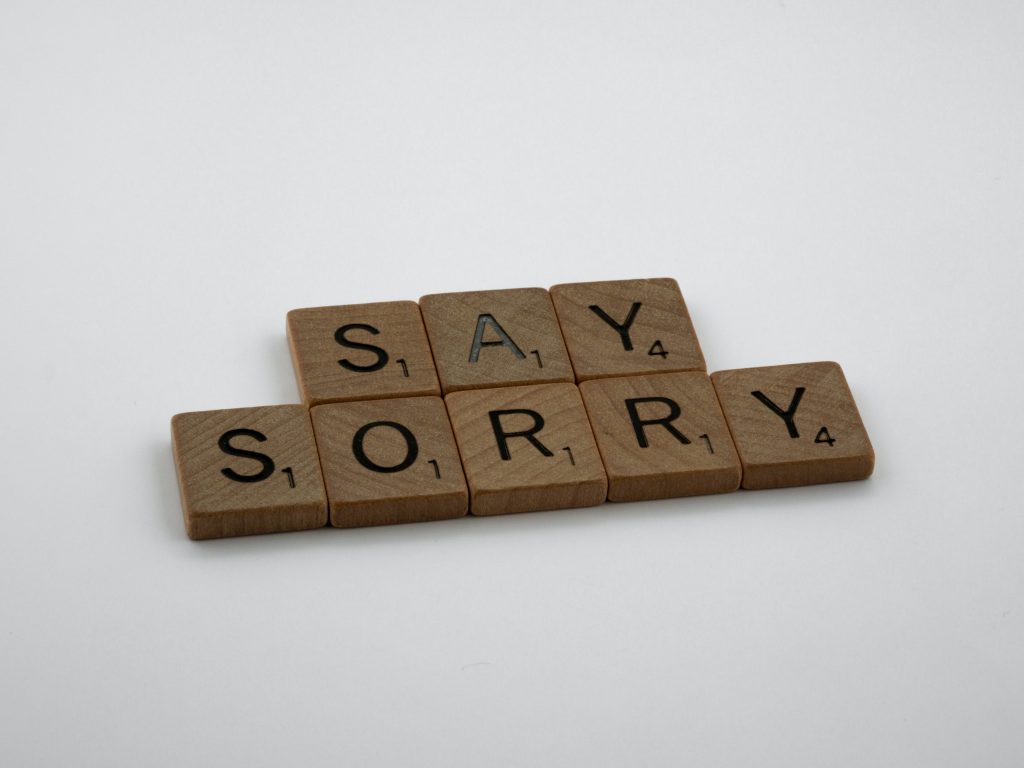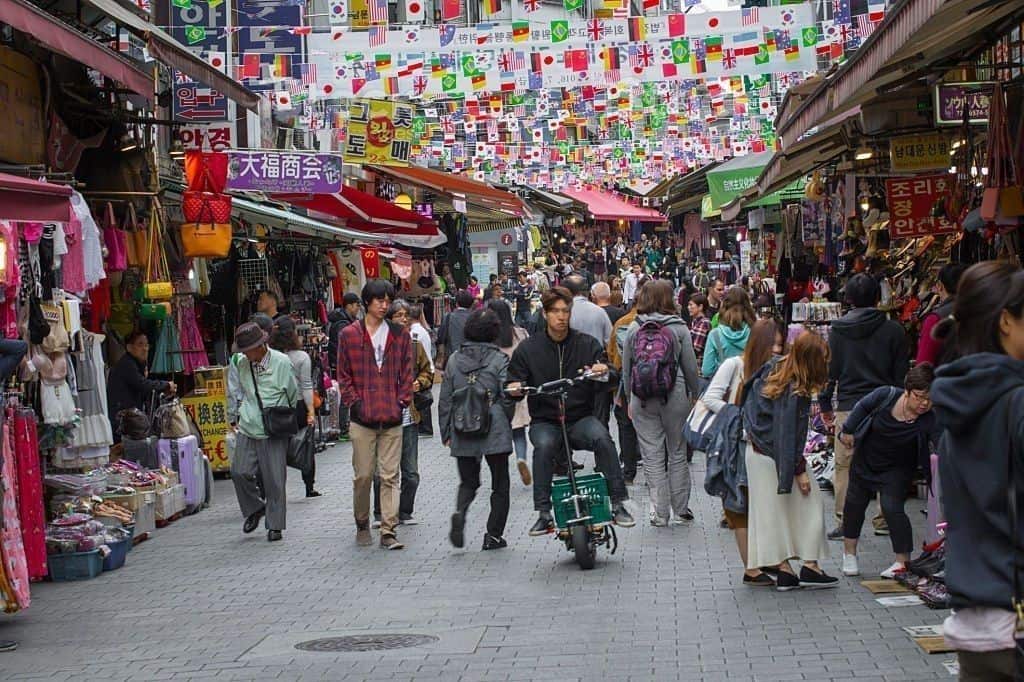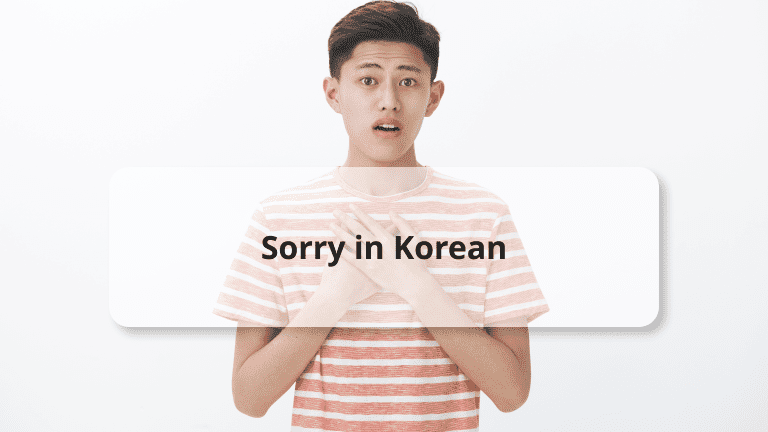Knowing how to apologize is a cornerstone of learning a new language so when traveling to a foreign country like Korea it’s imperative to be able to say sorry in Korean.
Much like learning how to say thank you in Korean, phrases of this nature are not as multifunctional in comparison to the English language. The Korean language emphasizes the use of honorifics. If you’re unfamiliar with this term read on as we’ll be touching on this later.
In the English language, sorry is an adjective that needs to be prefaced with a pronoun like ‘I’ to be grammatically correct. Saying sorry in Korean is different from this as ‘sorry’ is a verb in Korean. Koreans don’t use the pronoun ‘I’. in general, the context makes it evident that it’s the speaker that’s apologizing. However, If we’re saying sorry on someone else’s behalf, then we need to say who we’re saying sorry for.
When learning any new language there are bound to be mistakes and misunderstandings as you start. We’re going to try to minimize this by learning how to say sorry in Korean both formally and informally and in what contexts to use them we’ll also learn how to respond to an apology.
You won’t be sorry.
Formal ways to say sorry in Korean

미안해요 (mi-an-he-yo) – I’m sorry
We might as well start with the phrase featured in the title of this article. This phrase is considered the standard polite form of saying sorry in Korean. If there are any expressions you should familiarise yourself with, it should be this one.
If you’ve accidentally knocked over someone’s coffee or stepped on their foot, you can say 미안해요. It can also be used with people you are not familiar with, and with people who are older than you and in a more senior position than you.
Below are two examples of this phrase in a sentence:
You: 미안해요, 운전하고 있었어요.
You: mianhaeyo, unjeonhagoisseosseoyo.
You: “I am sorry, I was driving.”
Your colleague: 아 그러셨군요. 괜찮습니다.
Your colleague: a geureosyeotgunyo. gwaenchanseumnida.
Your colleague: “I see. It’s okay.”
You: 전화했었어요?. 못 받아서 미안해요.
You: jeonhwahaesseosseoyo?. mot badaseo mianhaeyo.
You: “Did you call? I am sorry for missing your calls.”
Other person: 괜찮습니다. 전화 주셔서 감사합니다.
Other person: gwaenchanseumnida. jeonhwa jusyeoseo gamsahamnida.
Other person: “It’s okay. Thank you for returning the call.”
죄송합니다 (joe-song-ham-ni-da) – I’m sorry
If there is one phrase to remember when trying to say sorry in Korean this would be it. Memorize it at all costs. If you apologize with this word, it means that things are serious. It indicates that one has indeed made a very serious mistake and asks for forgiveness.
This phrase is used in very formal situations, such as in job interviews, and is regularly used by people who work in the service industry to apologize to customers.
Body language is important in Korean culture as it conveys the intention of the phrases you use. As such using the appropriate body gesture is very important when you say this phrase. Unlike in some countries where eye contact is very important, making direct eye contact is considered rude in Korea. Face the person you are saying sorry to and slightly bow your head a little bit when saying sorry to acknowledge that you have made a mistake.
Below are two examples of this phrase in a sentence:
You: 어머, 괜찮으세요? 너무 *죄송합니다. [bow]
You: eomeo, gwaenchaneuseyo? neomu joesonghamnida.
You: “Oh no, are you okay? I am so sorry.”
Customer: 아, 괜찮습니다.
Customer: a, gwaenchanseumnida.
Customer: “Ah, it’s okay.”
You: 죄송합니다. [no need to bow in this situation]
You: joesonghamnida.
You: “I am sorry.”
Other person: 아니요, 괜찮습니다.
Other person: aniyo, gwaenchanseumnida.
Other person: “It’s okay, never mind.”
용서해주세요 (yongseohaejuseyo) – Please forgive me
This phrase is similar to 잘못했습니다 (jalmothaetseumnida) which means that you are indirectly requesting someone’s forgiveness and acknowledging that you made a mistake. The key difference is that 용서해주세요 (yongseohaejuseyo) means that you are directly asking for forgiveness.
If we break up the syllables of this phrase 용서 (yongseo) means “forgiveness,” and 해주세요 means “Please do ~,” so together, it means “Please forgive me.”
If you were unintentionally rude to your oppa you can use this phrase to apologize. To some extent, it can be equated to the English “I’m really sorry,”, but in Korean, it is more sincere.
Below are two examples of this phrase in a sentence:
You: 제가 잘못했어요. 한번만 용서해주세요.*
You: jega jalmothaesseoyo. hanbeonman yongseohaejuseyo.
You: “I made a mistake. Please forgive me.”
Parents: 알겠다. 이번 한번만 용서해주마.
Parents: algetda. ibeon hanbeonman yongseohaejuma.
Parents: “Understood. We will forgive you this time.”
You: 잘못했습니다. 용서해주세요.
You: jalmothaetseumnida. yongseohaejuseyo.
You: “I made a mistake. Please forgive me.”
Police officer: 면허증 주십시오.
Police officer: myeonheojeung jusipsio.
Police officer: “Please present your driver’s license.”
Informal ways to say sorry in Korean

미안해 (mi-an-he) – Sorry
This is the informal version of 미안해요 (mi-an-he-yo). This is achieved by removing the ending 요 from the polite form when speaking. If you are speaking to people of a similar age who are close to you it would be appropriate to use 미안해 (mi-an-he). It can also be used when speaking to young children.
If you are in a relationship and have said I love you in Korean, it can go a long way in saving your relationship. So you better learn it. Generally, you would use this phrase when speaking to your siblings and your cousins. Keep in mind that it is important that the close family members are of similar age to you as you shouldn’t be said to family members who are older than you.
Below are two examples of this phrase in a sentence:
You: 정말 미안해, 용서해주라. 응?
You: jeongmal mianhae, yongseohaejura. eung?
You: “I’m really sorry, can you forgive me. Ey?”
Your friend: 알았어. 이번 한번만 용서해줄께.
Your friend: arasseo. ibeon hanbeonman yongseohaejulkke.
Your friend: “Alright. I will forgive you this time.”
You: 많이 늦었지? 정말 미안해!
You: mani neujeotji? jeongmal mianhae!
You: “I’m so sorry for arriving late!”
Your friend: 괜찮아. 나도 방금 도착했어.
Your friend: gwaenchana. nado banggeum dochakaesseo.
Your friend: “It’s fine. I’ve just arrived too.”
미안 (mian) – Sorry
This can be considered as casual as an apology can get in Korean. It is usually used to apologise to your friends, and is the direct translation of “sorry.” This phrase can also be used to mean ‘no’ in certain situations. For example, when you’re invited to a party organized by your friend and want to politely decline, you can simply say 미안 (mian).
There is a shorter version that is considered slang which is 먄 (myan). However, it is important to note that Korean slang is used frequently in written contexts among young people as opposed to in speaking situations.
Below are two examples of this phrase in a sentence:
Your friend: 이번주 토요일에 이태원에서 하는 파티 갈래?
Your friend: ibeonju toyoire itaewoneseo haneun pati gallae?
Your friend: “Do you want to go to a party in Itaewon this Saturday?”
You: 음… 미안. 별로 가고 싶지 않네.
You: eum… mian. byeollo gago sipji anne.
You: “Hmm… sorry. I don’t feel like going.”
You: 늦어서 미안! (=먄!*)
You: neujeoseo mian!
You: “Sorry I’m late!”
Your friend: 괜찮아.
Your friend: gwaenchana.
Your friend: “It’s okay.”
저기요 (jeogiyo) – Excuse me
The translation of this phrase means ‘excuse me’ but you need to be careful to use this phrase in the proper context as 저기요 (jeogiyo) has two meanings. Firstly if you need to directly make a complaint to a person this phrase is used to draw attention to them. It is meant to give a negative feeling towards the intended persons so unless you want to complain to someone, just stick to the formal phrases.
The second meaning of this phrase is to call someone, especially at a restaurant. 저기요 (jeogiyo) is a very informal way to draw attention to yourself so do not use this phrase at a luxurious restaurant. However, it is common practice to make eye contact with staff members at a restaurant and raise your hand.
Below are two examples of this phrase in a sentence:
You: 저기요, 발을 밟았으면 사과해야 하는 거 아닌가요?
You: jeogiyo, bareul balbasseumyeon sagwahaeya haneun geo aningayo?
You: “Excuse me, if you stepped on my foot, aren’t you supposed to apologise to me?”
Stranger: 아, 몰랐습니다. 죄송합니다.
Stranger: a, mollatseumnida. joesonghamnida.
Stranger: “Oh, I did not know. I am sorry.”
You: 저기요~
You: jeogiyo~
You: “Excuse me!”
A waiter: 네~ 잠시만요.
A waiter: ne~ jamsimanyo.
A waiter: “Yes! One sec.”
Honorifics

Remember at the start of this article we said we would touch on honorifics? Here it is! In short, Honorific terms in Korean are special titles, words, and verbs in the Korean alphabet that are used to refer to people older than you or higher than you in the social hierarchy. This applies to saying sorry in Korean.
you need to use certain levels of formality to apologize in Korean. This depends on the age and seniority of the person you’re speaking to. If you’re not sure which one to use, always use polite speech.
There are 3 important situations you would find yourself in: apologizing to an older person, a younger person, and a person the same age as you. Below are some examples of each situation.
Older person
You: 바쁘신데 계속 방해해서 죄송해요.
You: bappeusinde gyesok banghaehaeseo joesonghaeyo.
You: “I am sorry to keep bothering you.”
You: 죄송해요 방해할 생각은 아니였어요.
You: joesonghaeyo banghae hal saenggageun aniyeosseoyo.
You: “Sorry, I didn’t mean to interrupt.”
Peer
You: 늦어서 미안! (=먄!*)
You: neujeoseo mian!
You: “Sorry I’m late!”
You: 음… 미안. 별로 가고 싶지 않네.
You: eum… mian. byeollo gago sipji anne.
You: “Hmm… sorry. I don’t feel like going.”
Younger person
You: * 정말 미안, 용서해주라. 응?
You: jeongmal mian, yongseohaejura. eung?
You: “I’m really sorry, can you forgive me. Ey?”
You: 많이 늦었지? 정말 미안!
You: mani neujeotji? jeongmal mian!
You: “I’m so sorry for arriving late!”
Other ways of apologizing in Korean
We’ve established both formal and informal ways to apologize in Korean, let’s look at some other ways.
- I am really sorry
버스를 놓쳐서 정말 미안해 – I am really sorry I missed the bus
- I am so sorry
네 전화를 놓쳐서 정말 미안해 – I am so sorry I missed your call
- excuse me
실례합니다, 당신과 부딪칠 생각은 없었습니다 – excuse me, I didn’t mean to bump into you
- I was wrong
나는 그 말을 잘못했다 – I was wrong to say that.
- It was my fault
차례를 놓친 건 내 잘못이야 – It was my fault you missed the turn
- Please forgive me
답변이 늦어진 점 양해 부탁드립니다 – Please forgive me for my late response
How to respond to an apology
괜찮아 (gwaenchana) – “It’s okay”
걱정마 (geokjeongma) – “Don’t worry”
용서해줄게 (yongseohaejulge) – “I’ll forgive you”
아니에요, 괜찮아요 (aniyo, gwaenchanayo) – “No, it’s okay. No worries”
문제 없어요 (munje eobseoyo) – “No problem”

Sorry our lesson is over
You now know how to say sorry in Korean both formally and informally. If you’re looking to learn something exciting, try learning how to say happy birthday in Korean.
As always the best way to learn a new language is by getting the help of a private tutor and you’re in luck because AmazingTalker has thousands of private tutors that have helped over 2 million students reach their goals.
Discover the answers to your language-related questions on AmazingTalker’s Q&A page.
















